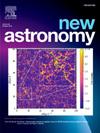用两种流体模拟紧凑恒星
IF 1.9
4区 物理与天体物理
Q2 ASTRONOMY & ASTROPHYSICS
引用次数: 0
摘要
在本文中,我们利用双流体模型方法研究了弯曲的 Krori-Barua 时空几何,以描述由暗物质和普通物质两部分组成的紧凑恒星。对于暗物质,我们选择了从星系旋转曲线推导出的状态方程,对于普通物质,我们选择了多向性状态方程。我们使用特定的参数来满足现实中紧凑型恒星的物理要求。对于各向同性指数η=2,我们找到了先前调查(Mafa 等人,2020 年)中报告的观测质量值。本文章由计算机程序翻译,如有差异,请以英文原文为准。
Modeling compact stars with two fluids
In this paper, we study the curved Krori–Barua spacetime geometry to describe compact stars with two components: dark and ordinary matter, using a two-fluid model approach. We choose the equation of state derived from the rotational curves of galaxies for dark matter and the polytropic equation of state for ordinary matter. The physical requirements for a realistic compact star are satisfied using specific parameters. For the polytropic index , we find the values of observed masses, reported in our previous investigation (Mafa et al., 2020).
求助全文
通过发布文献求助,成功后即可免费获取论文全文。
去求助
来源期刊

New Astronomy
地学天文-天文与天体物理
CiteScore
4.00
自引率
10.00%
发文量
109
审稿时长
13.6 weeks
期刊介绍:
New Astronomy publishes articles in all fields of astronomy and astrophysics, with a particular focus on computational astronomy: mathematical and astronomy techniques and methodology, simulations, modelling and numerical results and computational techniques in instrumentation.
New Astronomy includes full length research articles and review articles. The journal covers solar, stellar, galactic and extragalactic astronomy and astrophysics. It reports on original research in all wavelength bands, ranging from radio to gamma-ray.
 求助内容:
求助内容: 应助结果提醒方式:
应助结果提醒方式:


